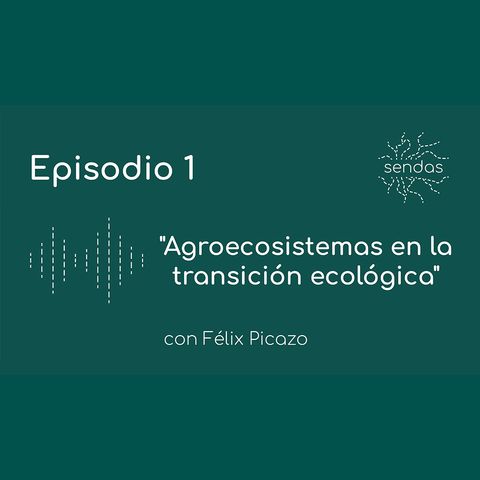Agroecosistemas en la transición ecológica #01

Descarga y escucha en cualquier lugar
Descarga tus episodios favoritos y disfrútalos, ¡dondequiera que estés! Regístrate o inicia sesión ahora para acceder a la escucha sin conexión.
Descripción
¿Qué son los agroecosistemas? ¿Qué es la intensificación ecológica? ¿Cuál es la relación actual entre biodiversidad y agricultura? ¿Todos los agroecosistemas protegen igual a la biodiversidad? ¿Qué puede aportar a...
mostra másConversamos acerca de estas cuestiones y otras con el Dr. Félix Picazo, investigador postdoctoral del Departamento de Ecología/Unidad de excelencia Modeling Nature (Universidad de Granada).
Recomendación de Félix Picazo:
- “Ecomandanga”: https://ecomandanga.org/
Referencias aportadas por Félix Picazo:
1. Bender S.F. & van der Heijden M.G.A. (2015). Soil biota enhance agricultural sustainability by improving crop yield, nutrient uptake and reducing nitrogen leaching losses. Journal of Applied Ecology 52, 228–239. https://doi.org/10.1111/1365-2664.12351
2. Grange G., Finn J.A. & Brophy C. (2021). Plant diversity enhanced yield and mitigated drought impacts in intensively managed grassland communities. Journal of Applied Ecology 58, 1864–1875. https://doi.org/10.1111/1365-2664.13894
3. Griscom B.W., Adams J., Ellis P.W., Houghton R.A., Lomax G., Miteva D.A., et al. (2017). Natural climate solutions. Proceedings of the National Academy of Sciences 114, 11645–11650. https://doi.org/10.1073/pnas.1710465114
4. Habel J.C., Rasche L., Schneider U.A., Engler J.O., Schmid E., Rödder D., et al. (2019). Final countdown for biodiversity hotspots. Conservation Letters 12, e12668. https://doi.org/10.1111/conl.12668
5. Isbell F., Adler P.R., Eisenhauer N., Fornara D., Kimmel K., Kremen C., et al. (2017). Benefits of increasing plant diversity in sustainable agroecosystems. Journal of Ecology 105, 871–879. https://doi.org/10.1111/1365-2745.12789
6. Jones M.S., Fu Z., Reganold J.P., Karp D.S., Besser T.E., Tylianakis J.M., et al. (2019). Organic farming promotes biotic resistance to foodborne human pathogens. Journal of Applied Ecology 56, 1117–1127. https://doi.org/10.1111/1365-2664.13365
7. MacInnis G. & Forrest J.R.K. (2019). Pollination by wild bees yields larger strawberries than pollination by honey bees. Journal of Applied Ecology 56, 824–832. https://doi.org/10.1111/1365-2664.13344
8. Martin E.A., Dainese M., Clough Y., Báldi A., Bommarco R., Gagic V., et al. (2019). The interplay of landscape composition and configuration: new pathways to manage functional biodiversity and agroecosystem services across Europe. Ecology Letters 22, 1083–1094. https://doi.org/10.1111/ele.13265
9. Paredes D., Rosenheim J.A., Chaplin-Kramer R., Winter S. & Karp D.S. (2021). Landscape simplification increases vineyard pest outbreaks and insecticide use. Ecology Letters 24, 73–83. https://doi.org/10.1111/ele.13622
10. Pywell R.F., Heard M.S., Woodcock B.A., Hinsley S., Ridding L., Nowakowski M., et al. (2015). Wildlife-friendly farming increases crop yield: evidence for ecological intensification. Proceedings of the Royal Society B: Biological Sciences 282, 20151740. https://doi.org/10.1098/rspb.2015.1740
11. Sawe T., Eldegard K., Totland Ø., Macrice S. & Nielsen A. (2020). Enhancing pollination is more effective than increased conventional agriculture inputs for improving watermelon yields. Ecology and Evolution 10, 5343–5353. https://doi.org/10.1002/ece3.6278
12. Terrer C., Phillips R.P., Hungate B.A., Rosende J., Pett-Ridge J., Craig M.E., et al. (2021). A trade-off between plant and soil carbon storage under elevated CO 2. Nature 591, 599–603. https://doi.org/10.1038/s41586-021-03306-8
Información
| Autor | Podcastidae |
| Organización | Podcastidae |
| Página web | - |
| Etiquetas |
Copyright 2024 - Spreaker Inc. an iHeartMedia Company

Comentarios